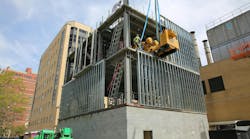Electrical workers inside the Pentagon in the early morning hours of September 11 narrowly escaped death and injury, as terrorists used a commercial jet as a fuel-filled missile in an assault on the United States, reported NECA headquarters in a late September press release.
"It was close," said Jack Singleton, president of Gaithersburg, Md.-based Singleton Electric Co., Inc. "Fifteen minutes earlier and I'd have some dead guys down there. We were blessed."
Singleton Electric was the Wedge One electrical contractor and had just completed some punch-list work when American Airlines Flight 77 plowed into the western wall of Pentagon (between the first and second wedges) with 64 passengers and crew aboard at 9:45 a.m. (EDT). According to witnesses on the scene, the jet came in from the south and banked left as it entered the building, narrowly missing the Singleton Electric trailer and the on-site foreman, Mickey Bell. Bell had just left the trailer when he heard a loud noise. The next thing he recalled was picking himself off the floor, where he had been thrown by the blast.
Bell, who had been less than 100 ft from the initial impact of the plane, was nearly struck by one of the plane's wings as it sped by him. In shock, he got into his truck, which had been parked in the trailer compound, and sped away. He wandered around Arlington in his truck and tried to make wireless phone calls. He ended up back at Singleton's headquarters in Gaithersburg two hours later, not remembering much.
According to NECA, the full impact of the closeness of the crash wasn't realized until coworkers noticed damage to Bell's work vehicle. He had plastic and rivets from an airplane imbedded in its sheet metal, but Bell had no idea what had happened.
During Bell's close call, other Singleton workers, including sub-foreman Greg Cobaugh, were doing other work on the first and third floors. The blast wasn't very loud to them. They were talking about reports that two planes crashed into the World Trade Center in Manhattan—not considering the noise they heard could be a similar attack. Then, security began running around the building, evacuating everyone. Cobaugh gathered the electrical workers from Singleton and fled toward the loading dock area. Security officers told them to run, as there was a threat of another plane 10 miles away, headed for the Pentagon. Cobaugh said that's when he really got scared. The crew then ran toward Arlington Cemetery to safety.
Meanwhile, Jack Singleton was leaving another job in Maryland, listening to his radio with another employee. The news was coming in about the Twin Towers in New York, but nothing had been reported in the media about the Pentagon. As he looked at black smoke billowing into the sky, he wondered what was ablaze. His colleague said: "Jack, that's the Pentagon." Shortly thereafter, the media reported the terrorist attack on the Pentagon.
"I had no idea what had happened to my guys" Singleton said. As it turned out, all of his personnel escaped unscathed, but a bit shaken up. Singleton Electric also had 90 workers in the Customs building and 31 in the Treasury building at the time of the attack on America—all were evacuated eventually for precautionary reasons.
Later that night, Bell and other Singleton personnel returned to the Pentagon to set up temporary lighting for the rescue crews. Singleton Electric was on call throughout the rescue and recovery operation, as they provided backup power and helped restore power to sections of the Pentagon.
For stories from NECA contractors who were at the Pentagon at the time of the disaster and information on how you can help, visit www.necanet.org.
Photo courtesy of the Federal Emergency Management Agency (FEMA), Washington, D.C.


